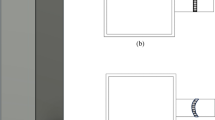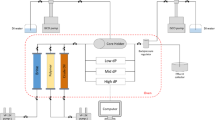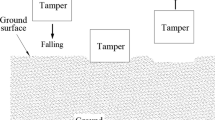Abstract
The lower reaches of the Yangtze River is one of the most developed regions in China. It is desirable to build compressed air energy storage (CAES) power plants in this area to ensure the safety, stability, and economic operation of the power network. Geotechnical feasibility analysis was carried out for CAES in impure bedded salt formations in Huai’an City, China, located in this region. First, geological investigation revealed that the salt groups in the Zhangxing Block meet the basic geological conditions for CAES storage, even though the possible unfavorable characteristics of the salt formations include bedding and different percentages of impurities. Second, mechanical tests were carried out to determine the mechanical characteristics of the bedded salt formations. It is encouraging that the samples did not fail even when they had undergone large creep deformation. Finally, numerical simulation was performed to evaluate the stability and volume shrinkage of the CAES under the following conditions: the shape of a single cavern is that of a pear; the width of the pillar is adopted as two times the largest diameter; three regular operating patterns were adopted for two operating caverns (internal pressure 9–10.5 MPa, 10–11.5 MPa, and 11–12.5 MPa), while the other two were kept at high pressure (internal pressure 10.5, 11.5, and 12.5 MPa) as backups; an emergency operating pattern in which two operating caverns were kept at atmospheric pressure (0.1 MPa) for emergency while the backups were under operation (9–10.5 MPa), simulated for 12 months at the beginning of the 5th year. The results of the analysis for the plastic zone, displacement, and volume shrinkage support the feasibility of the construction of an underground CAES power station.
















Similar content being viewed by others
Abbreviations
- V cavern :
-
Volume of cavern
- G eff :
-
Volume of working gas
- M air :
-
Molar mass of gas
- V mol :
-
Molar volume of gas at standard state
- V sediment :
-
Volume of sediment
- V sphere :
-
Volume of lower half-sphere
- h sediment :
-
Distance between sediment surface and the above cross-section
- v :
-
Withdrawal velocity
- t :
-
Withdrawal time
- N :
-
Mole number of gas
- R m :
-
Ideal gas constant, 8.314 J/(mol K)
- a :
-
Average insoluble content percentage at the location of the cavern
- b :
-
Expansion coefficient of sediment
- A max :
-
Cross-sectional area at the maximum diameter
- A 1, A 2 :
-
Coefficients in virial equation
- A :
-
Material constant in creep model
- n :
-
Stress exponent constant in creep model
- σ * :
-
Unit stress, 1 MPa
- \(\dot{\varepsilon }_{\text{s}}\) :
-
Steady-state creep rate
- σ 1, σ 3 :
-
Maximum and minimum principal stress
- S, S s, S m :
-
Generalized mechanical parameters of the strata, rock salt, and mudstone
- R :
-
Proportion occupied by impurity
- E :
-
Young’s modulus
- μ :
-
Poisson’s ratio
- c :
-
Cohesion
- φ :
-
Internal friction angle
- σ t :
-
Tensile strength
- T :
-
Thermodynamic temperature of gas
- P :
-
Pressure of gas
- V :
-
Volume of gas
- Z :
-
Compressibility factor of gas
- P sc,max,min :
-
Pressure of gas at standard state, high pressure, or low pressure, respectively
- T sc,max,min :
-
Thermodynamic temperature of gas at standard state, high pressure, or low pressure, respectively
- Z sc,max,min :
-
Compressibility factor of gas at standard state, high pressure, or low pressure, respectively
References
Bérest P, Brouard B (2003) Safety of salt caverns used for underground storage blow out; mechanical instability; seepage; cavern abandonment. Oil Gas Sci Technol 58(3):361–384
Chan KS (1997) A damage mechanics treatment of creep failure in rock salt. Int J Damage Mech 6(2):121–152
Chan KS, Bodner SR, Munson DE (1997) Treatment of anisotropic damage development within a scalar damage formulation. Comput Mech 19:522–526
Chan KS, Munson DE, Bonder SR (1998) Recovery and healing of damage in WIPP salt. Int J Damage Mech 7(2):143–166
Crotogino F, Mohmeyer KU, Scharf R (2001) Huntorf CAES: more than 20 years of successful operation. In: Proceedings of solution mining research institute meeting, Orlando, USA, April 15–18
DeVries KL, Mellegard KD, Callahan GD, Goodman WM (2005) Cavern roof stability for natural gas storage in bedded salt. United States Department of Energy National Energy Technology Laboratory, South Dakota
Giramonti AJ, Lessard RD, Blecher WA, Smith EB (1978) Conceptual design of compressed air energy storage electric power systems. Appl Energy 4(4):231–249
Glendenning I (1976) Long-term prospects for compressed air storage. Appl Energy 2(1):39–56
Hampel A, Hunsche U, Weidinger P, Blum W (1996) Description of the creep of rock salt with the composite model-II. Steady-State creep. In: Proceedings of the 4th conference on the mechanical behavior of salt, Montreal PQ, Canada
Hou ZM, Lux KH (1999) Some new developments in the design of pillars in salt mining. In: Proceedings of 9th ISRM Congress. International Society for Rock Mechanics, Paris, France
Hou ZM, Wu W (2003) Improvement of design of storage cavity in rock salt by using the Hou/Lux constitutive model with consideration of creep rupture criterion and damage. Chin J Geotech Eng 25(1):104–108 (in Chinese)
Huang XL, Yang CH, Li YP (2009) Discussion on underground energy storage in salt cavern and its tightness evaluation method. In: Proceedings of 2009 international conference on management science and engineering, Beijing, China
Khaitan SK, Raju M (2012) Dynamics of hydrogen powered CAES based gas turbine plant using sodium alanate storage system. Int J Hydrogen Energ 37(24):18904–18914
Khaitan SK, Raju M (2013) Dynamic simulation of air storage-based gas turbine plants. Int J Energ Res 37(6):558–569
Kim HM, Rutqvist J, Ryu DW, Choi BH, Sunwoo C, Song WK (2012) Exploring the concept of compressed air energy storage (CAES) in lined rock caverns at shallow depth: a modeling study of air tightness and energy balance. Appl Energy 92:653–667
Kim HM, Rutqvist J, Jeong JH, Choi BH, Ryu DW, Song WK (2013) Characterizing excavation damaged zone and stability of pressurized lined rock caverns for underground compressed air energy storage. Rock Mech Rock Eng 46(5):1113–1124
Kushnir R, Ullmann A, Dayan A (2010) Compressed air flow within aquifer reservoirs of CAES plants. Transp Porous Med 81:219–240
Li YP, Liu J, Yang CH (2006) Influence of mudstone interlayer on deformation and failure characteristics of salt rock. Chin J Rock Mech Eng 25(12):2461–2466 (in Chinese)
Li YP, Jiang WD, Liu J, Chen JW, Yang CH (2007a) Direct shear test for layered salt rocks of Yunying salt mine in Hubei Province. Chin J Rock Mech Eng 26(9):1767–1772 (in Chinese)
Li YP, Yang CH, Qian QH, Wei DH, Qu DA (2007b) Experimental research on deformation and failure characteristics of laminated salt rock. In: Proceedings of the 6th conference on the mechanical behaviors of salt, London, Britain
Li YP, Yang CH, Daemen JJK, Yin XY, Chen F (2009) A new Cosserat-like constitutive model for bedded salt rocks. Int J Numer Anal Methods 33(15):1691–1720. doi:10.1002/nag.784
Liang W, Yang C, Zhao Y, Dusseault MB, Liu J (2007) Experimental investigation of mechanical properties of bedded salt rock. Int J Rock Mech Min Sci 44:400–411
Munson DE (1997) Constitutive model of creep in rock salt applied to underground room closure. Int J Rock Mech Min Sci 34(2):233–247
Preece DS, Ehgartner BL (1994) Structural stability of the Weeks Island oil repository. Sandia National Labs, Albuquerque
Raju M, Khaitan SK (2011) Modeling and simulation of compressed air storage in caverns: a case study of the Huntorf plant. Appl Energy 89(1):474–481
Ren S, Bai YM, Zhang JP, Jiang DY, Yang CH (2013) Experimental investigation of the fatigue properties of salt rock. Int J Rock Mech Min Sci 64:68–72
Rutqvist J, Kim HM, Ryu DW, Synn JH, Song WK (2012) Modeling of coupled thermodynamic and geomechanical performance of underground compressed air energy storage in lined rock caverns. Int J Rock Mech Min Sci 52:71–81
Shidahara T, Nakagawa K, Ikegawa Y, Suenaga H, Miyamoto Y (2001) Demonstration study for the compressed air energy storage technology by the hydraulic confining method at the Kamioka testing site. Central Research Institute of the Electrical Power Industry, Tokyo, Japan (in Japanese)
Shinohara T, Aida Y, Kawakami H, Fukuda K (2001) High compressed air storage in rock bed 450 meter down below the ground Kami-sunagawa pilot plant construction work. Tunnels Undergr 32:495–503 (in Japanese)
Smith JM, Van Ness HC, Abbott MM (2005) Introduction to chemical engineering thermodynamics. McGraw Hill, New York
Succar S, Williams RH (2008) Compressed air energy storage: theory, resources, and applications for wind power. Princeton Environmental Institute, Princeton
van der Waals JD (1873) On the continuity of the gaseous and liquid states. Ph.D. dissertation, Leiden University, Leiden, The Netherlands
Wang XM, Sha YN, Gong YC, et al. (2009) The detailed geological investigation of Zhangxing block in Chuzhou District of Huai’an City, Jiangsu Province. Jiangsu Yangtze River Geological Prospecting Institute, Nanjing, China (in Chinese)
Wang TT, Yan XZ, Yang HL, Yang XJ, Jiang TT, Zhao S (2013) A new shape design method of salt cavern used as underground gas storage. Appl Energy 104:50–61
Wei F (2013) Nineteen underground gas storages in salt caverns of Jintan city have been accomplished which is available for 12 days’ urgent application for Shanghai and Jiangsu Province. http://news.cnpc.com.cn/system/2013/06/14/001432238.shtml (in Chinese)
Weidinger P, Hampel A, Blum W, Hunshe U (1997) Creep behaviour of natural rock salt and its description with the composite model. Mater Sci Eng 234–236:646–648
Wu W, Hou ZM, Yang CH (2005) Investigations on evaluating criteria of stabilities for energy (petroleum and natural gas) storage caverns in rock salt. Chin J Rock Mech Eng 24(14):2497–2505 (in Chinese)
Yang H (2009) Stability analysis of the underground gas storage in salt rock in the process of compressed air energy storage. M.E. dissertation. Chinese Academy of Sciences and Technology, Wuhan, China (in Chinese)
Zhang GM (2013) Studies on the failure criterion of thin interbedded salt formations and its application considering the sedimentary characteristics of interfaces. Ph.D. dissertation. Chinese Academy of Sciences and Technology, Wuhan, China (in Chinese)
Zhang GM, Li YP, Yang CH, Daemen JJK (2014) Stability and tightness evaluation of bedded rock salt formations for underground gas/oil storage. Acta Geotech 9(1):161–179
Zhou SW, Xia CC, Du SG, Zhang PY, Zhou Y (2014) An analytical solution for mechanical responses induced by temperature and air pressure in a lined rock cavern for underground compressed air energy storage. Rock Mech Rock Eng. doi:10.1007/s00603-014-0570-4
Zong XL (2013) Effect of impurities on engineering mechanical properties of salt rock. Ph.D. dissertation. Chinese Academy of Sciences and Technology, Wuhan, China (in Chinese)
Acknowledgments
The authors acknowledge the financial support from the National Basic Research Program of the Science Foundation of China (973 Program) (2013CB227900), a China Postdoctoral Science Foundation funded project (2014M560462), Jiangsu Planned Projects for Postdoctoral Research Funds (1401097C), The National Natural Science Funds of China (41401397), and The Natural Science Funds of Jiangsu Province (BK20140237).
Author information
Authors and Affiliations
Corresponding author
Rights and permissions
About this article
Cite this article
Zhang, G., Li, Y., Daemen, J.J.K. et al. Geotechnical Feasibility Analysis of Compressed Air Energy Storage (CAES) in Bedded Salt Formations: a Case Study in Huai’an City, China. Rock Mech Rock Eng 48, 2111–2127 (2015). https://doi.org/10.1007/s00603-014-0672-z
Received:
Accepted:
Published:
Issue Date:
DOI: https://doi.org/10.1007/s00603-014-0672-z




